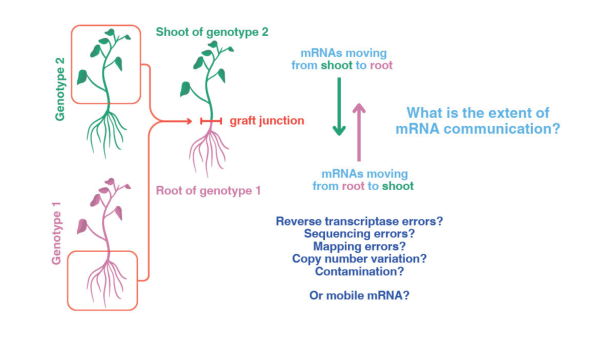
A far-reaching study has cast doubt on statistical methods used to identify long distance signalling networks in plants.
The surprising findings by a John Innes Centre-led collaboration mean we may need to reevaluate a vital area of the life sciences.
The movement of messenger RNAs (mobile mRNAs) between cells and tissues has been reported to play a significant role in long-distance signalling in plants.
Thousands of mobile mRNAs have been reported and proposed to act like a plant internet, as components of a complex intercellular communications system that regulates plant development and physiological processes.
Understanding how plants communicate and respond to their environment has potential applications for agriculture, biotechnology, and even our fundamental understanding of evolution.
To determine the presence of these messaging molecules, researchers use a technique that involves grafting one plant onto another and tracking the progress of mRNAs as they pass from root to shoot, or vice versa, across the graft junction.
The actual tracking is enabled by an experimental technique called RNA sequencing (RNA seq) which can identify differences in the sequences of mRNAs that might indicate the presence of mobile mRNA.
However, a problem when analysing RNA seq data sets lies in distinguishing between differences in the sequences, which might arise from a graft-mobile mRNA signal, and "noise."
To investigate, the John Innes Centre team used bioinformatics, genomic tools and machine learning approaches, devising a series of statistical tests to distinguish potential signals from noise in the data.
In a study, which appears in Nature Plants, meta-analysis of RNA seq datasets found that up to 83% of data obtained from grafted plants are indistinguishable from the sort of background noise that can be expected in this approach. Taking genome mis-mapping and potential contamination into account reduces the number of mobile candidates even further.
The research has uncovered what one expert reviewer described as an "elephant in the room" and has major implications for the field.
The finding that currently annotated mobile mRNAs lack statistical basis challenges current thinking on the extent of mRNA communication.
Professor Richard Morris, corresponding author of the study which appears in Nature Plants, said: "Our analysis questions the number and signaling potential of mobile mRNAs in plants."
Dr Melissa Tomkins, co-first author, explains: "The aim was to develop models for mRNA transport but the lack of features in the data motivated us to take a closer look."
Franziska Hoerbst, co-first author, added "The deeper we dug, the less support we found for mobile mRNA. The science took us in quite different directions than expected, leading us back to 18th century maths."
Dr Pirita Paajanen, lead and co-corresponding author, commented: "This study highlights the importance of making data openly accessible. It is a nice example of the power of mathematics in biology."
Following these findings, the team have put together a set of recommendations to help future researchers develop more robust approaches for studying long distance mRNA transport.
Professor Morris added: "I wish to think the fantastic team at JIC for their outstanding work and our excellent collaborators - their contributions were key to unravelling causality in what is perhaps one of most challenging datasets we've dealt with to date."
Re-analysis of mobile mRNA datasets raises questions about the extent of long-distance mRNA communication appears in Nature Plants.






